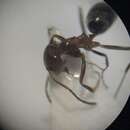en
names in breadcrumbs


These generalist, ground-nesting ants are frequent in open habitats at medium to low elevations. The two commonest species, D. bicolor Wheeler and D. insanus (Buckley) , are usually distinguishable on the basis of color, with the former being bicolored (head and mesosoma orange- or reddish-brown, metasoma brownish-black) and the latter unicolorous dark brown, but some samples are intermediate in color. Snelling (1995a) describes additional worker differences in head shape and eye size, but these characters are quite variable and are not always reliable. This group of ants continues to be burdened with taxonomic uncertainties, possibly as a result of occasional interspecific hybridization.
Species identification: key in Snelling (1995a). Additional references. Berkelhamer (1984), Johnson (1989b), Martinez (1995), Snelling and George (1979), Trager (1988a), Wheeler and Wheeler (1986g).
Boquerón (ALWC).
Femina: Caput ovale, supra convexum, postice excavatum. pone medium latissimum. Clypeus transverse triangularis, inter antennarum articulationes intersertus, non depressus, medio convexus. Area frontalis acute triangularis. Sulcus frontalis brevis at distinctus. Antennae 12 articulatae. Thorax compressus. Scutellum medio deplanatum. Metanotum inerme. Petiolus unimaculatus squama erecta, ovata, supra obtuse dentiformi. Abdomen elongato-ovale. Pedes graciles. Calcaria pedum mediorum longa acicularia, recta, pedum posticorum acicularia, intermediis longiora et curvata. Alae anticue cellulis cubitalibus duabus.
Mas: Mandibulae cruciatae, deplanatae, modice longae, margine masticatorio multidenticulato apice acutissimo. Clypeus transverse triangularis, paulo inter antennarum articulationes intersertus, medio convexus. Laminae frontales breves, rectae. Antennae 13 articulatae, funiculi articulis 2 basalibus ceteris longioribus. Mesonotum supra pronotum productum. Scutellum magnum, valde convexum. Metanotum inerme. Petiolus uniarticulatus supra paulo nodiforme. Abdomen ovale, antice prope articulationem petiolar em breve petiolatum. Pedum gracillimorum posteriorum calcaria acicularia. Genitalium valvulae externae compressae, sublineares apice rotundatae.
Von den (Tattungen der Subfamilie Formicidae mit zwei Cubitalzellen, naemlich Hypoclinea , Liometopum und der nachfolgend beschriebenen ( Linepithema ) ist dieses neue Genus leicht durch die nadel-, und. nicht kammfoermigen Sporne zu unterscheiden.
Das Weibchen weicht von Hypoclinea noch durch den vorne nicht eingedrueckten, sondern ziemlich stark convexen Clypeus ab, welcher ziemlich kurz ist und wenig zwischen die Fuehlergelenke eingeschoben ist, ferner durch das unbewehrte Metanotum, obschon das bewehrte Metanotum fuer Hypoclinea kein sicheres Merkmal sein duerfte. Von Liometopum unterscheidet es sich noch durch den Clypeus, durch den ovalen Kopf, welcher kaum breiter ist als der Thorax, und durch den compressen Thorax. Es finden sich noch mehrere Merkmale, welche aber von geringerer Bedeutung sind. Die Mandibeln sind gekreuzt mit gezaehntem Kaurande und mit ziemlich lang ausgezogener, schwach sichelfoermig gekruemmter Spitze. Die Netzaugen stehen mehr nach vorne als an der Seite. Im Allgemeinen hat das Weibchen den Habitus von Camponotus .
Das mir vorliegende Maennchen weicht in der Fluegelzellenbildung vom Weibchen dadurch ab, dass nur eine Cubitalzelle ausgebildet. ist. Diess ist aber nur eine individuelle Abnormitaet, indem diese durch das Ausbleiben des aeusseren Astes der Cubitalrippe bis zur Kreuzung mit der Costa transversa entstanden ist. Eine solche mangelhafte Entwicklung kann dennoch nicht irre fuehren, weil von der Costa transversa die zwei Cubitalaeste parallel oder ziemlich parallel nach hinten verlaufen, was nicht der Fall sein wuerde, wenn nur die Anlage zu einer Cubitalzelle vorhanden waere. (Diess ist stets genau zu beruecksichtigen, weil die blosse Angabe, dass nur eine Cubitalzelle vorhanden ist, in einem solchen Falle zu einer irrigen Auffassung Anlass geben wuerde.)
Dorymyrmex (also known as cone ants) is a genus of ants in the subfamily Dolichoderinae.
This genus has a strictly American distribution, inhabiting in the Nearctic and Neotropical regions and containing 60 species, several undescribed. Despite being considered by many ant collectors as "road side weeds", several species of Dorymyrmex shown a high degree of endemicity, specialized habitat preferences, and varied population structure. Some species may serve as potential agents of biological control of annual crop pests. Species of Dorymyrmex nest preferentially in dry or disturbed habitats, generally in soil without vegetation cover. Several species are known to attend aphids and other hemipterous insects. Such behavior is common in other Dolichoderinae genera and related subfamilies.[2]
Dorymyrmex (also known as cone ants) is a genus of ants in the subfamily Dolichoderinae.